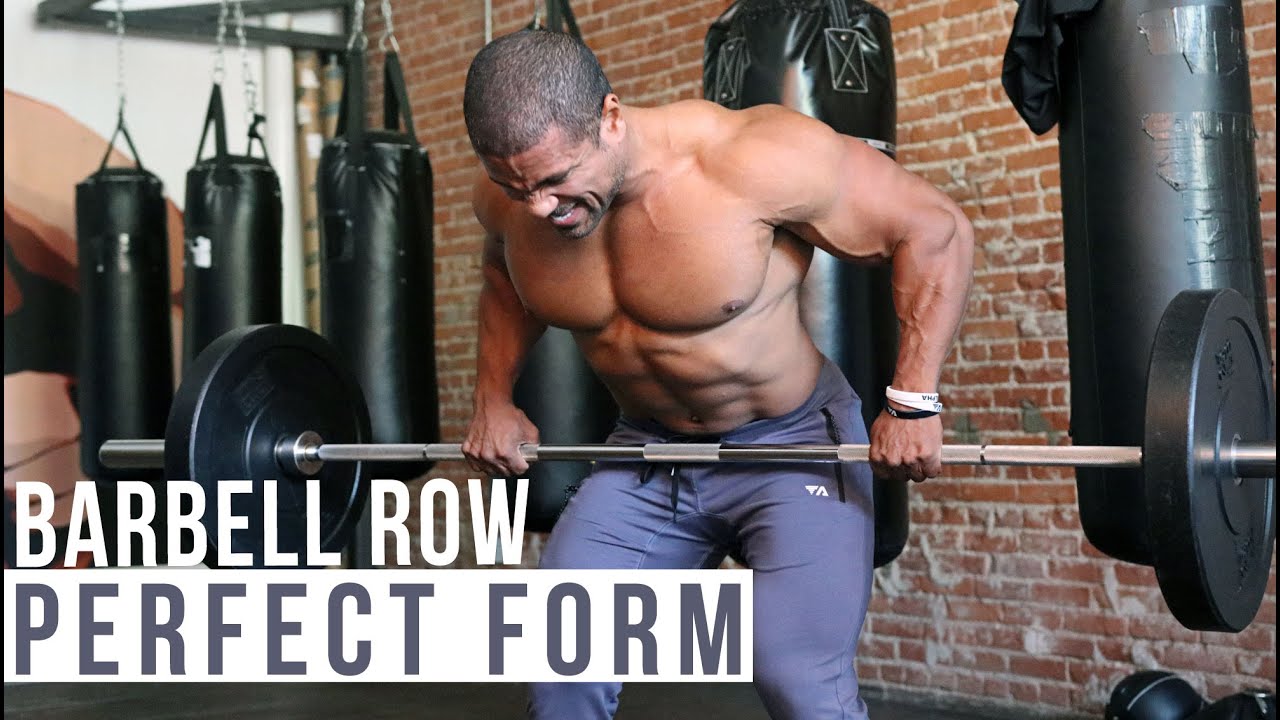
The barbell row, also known as the bent-over barbell row, is a full-body compound exercise that works multiple muscle groups in your body, including the lower back, upper back, legs, and arms. In particular, the barbell row works several muscles in your back, including the latissimus dorsi, the infraspinatus muscle, the rhomboids, the erector spinae muscles, and the posterior deltoid muscles (also called the rear delts). The barbell row is more than simply a back exercise; it also works your triceps, hamstrings, and glutes.
Barbell Row vs. T-Bar Row: What’s the Difference?
There are dozens of variations of the conventional barbell row, including the underhand grip row, the inverted row, the bodyweight row, and the dumbbell row. One of the most popular row variations is the T-bar row. While the barbell row and T-bar row work many of the same muscle groups, there are a few key differences between them.
Barbell placement: For the traditional barbell row, you hold the barbell directly in front of you and lift it toward your chest. For the T-bar row, you straddle the barbell and lift one end between your legs while the other remains on the ground.
Grip: Another difference between the two row variations is the grip technique. When performing the barbell row, your hands grip the bar on the outside of your knees. In contrast, you place your hands between your knees for the T-bar row.
Range of motion. With a wider grip, the barbell row has a slightly greater range of motion than the T-bar row, allowing more movement in your shoulder joints. In order to avoid shoulder injury, be sure to use lighter weights at first, especially if you’re a novice lifter.
Both the barbell row and T-bar row are excellent workouts to encourage hypertrophy in your back muscles, especially when combined with other strength training exercises like pull-ups, lat pulldowns, bench presses, or deadlifts.
How to Do a Barbell Row with Proper Form
For the barbell row, begin by using a weight that you can control for 2–3 sets of 6–10 repetitions. Choose a weight that allows you to maintain good technique throughout all sets and repetitions.
1. Get set up. Stand directly in front of the barbell with your midfoot aligned underneath of the middle of the barbell. Your posture should be tall with your back straight and your feet shoulder-width apart. Keep a slight bend in your knees. Your shoulders should be directly over your hips with a neutral head and neck position. Your chin should remain tucked throughout the movement, as if you were holding an egg under your chin. The weight on your feet should be evenly distributed along each entire foot. Grip the floor with your feet to create a stable foot position. Your arms should remain long by your sides with a slight bend in your elbows.
2. Pretension your shoulders and hips while engaging your core before lowering toward the barbell.
3. Hinge from your hips, and bend your hips and knees to lower your body toward the barbell.
4. With an overhand grip, grab the barbell just outside of your knees. Engage your back muscles by rotating your arms outward, and push your feet into the ground to stand.
5. While maintaining a neutral spine, hinge your hips back. Your shins should be vertical and your upper body should be at a 30- to 45-degree angle. You should feel your legs working to support your position. All repetitions should start from this position.
6. Initiate the upward movement by squeezing your lats and pulling the barbell toward your hips. Your elbows should travel behind you at a 45-degree angle. Your shoulder blades should naturally retract as you pull the barbell close to your body. Your upper arms should be in line with your body with your arms bent at a 90-degree angle.
7. Begin the downward movement. While maintaining your rowing alignment, straighten your elbows, and allow the barbell to travel back to the starting position.
8. Your shoulder blades should naturally protract as your elbows straighten and the barbell moves away from your body.
How to Work out Safely and Avoid Injury
If you have a previous or pre-existing health condition, consult your physician before beginning an exercise program. Proper exercise technique is essential to ensure the safety and effectiveness of an exercise program, but you may need to modify each exercise to attain optimal results based on your individual needs. Always select a weight that allows you to have full control of your body throughout the movement. When performing any exercise, pay close attention to your body, and stop immediately if you note pain or discomfort.
In order to see continual progress and build body strength, incorporate proper warm-ups, rest, and nutrition into your exercise program. Your results will ultimately be based on your ability to adequately recover from your workouts. Rest for 24 to 48 hours before training the same muscle groups to allow sufficient recovery.